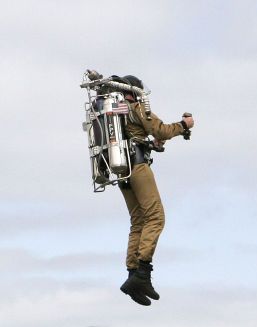Difference between revisions of "Jetpack"
| Line 5: | Line 5: | ||
Existing "jetpacks" provide thrust by converting concentrated hydrogen peroxide into high-pressure water vapor and oxygen, making them more like rockets than jets. Nozzles direct the gas downward along the wearer's center of mass to create lift. The wearer steers by tilting the mechanism to direct the thrust, which is controlled by a throttle in one of the hand grips. Modern jetpacks are not practical devices because they typically carry enough propellant for less than a minute of flight. | Existing "jetpacks" provide thrust by converting concentrated hydrogen peroxide into high-pressure water vapor and oxygen, making them more like rockets than jets. Nozzles direct the gas downward along the wearer's center of mass to create lift. The wearer steers by tilting the mechanism to direct the thrust, which is controlled by a throttle in one of the hand grips. Modern jetpacks are not practical devices because they typically carry enough propellant for less than a minute of flight. | ||
A jetpack that actually uses small turbojet engines does exist. This version was far more complicated and expensive, and only one was ever built. It could, however, sustain | A jetpack that actually uses small turbojet engines does exist. This version was far more complicated and expensive, and only one was ever built. It could, however, sustain a pilot in flight for several minutes. | ||
Swiss ex-military and commercial pilot Yves Rossy developed and built a working winged pack that uses four small jet engines originally developed for model planes. Rossy's version can sustain him in flight for several minutes, but he must drop out of a plane instead of taking off from the ground, and he must use a parachute to land. | Swiss ex-military and commercial pilot Yves Rossy developed and built a working winged pack that uses four small jet engines originally developed for model planes. Rossy's version can sustain him in flight for several minutes, but he must drop out of a plane instead of taking off from the ground, and he must use a parachute to land. | ||
Revision as of 17:57, 9 December 2008
A jetpack is a device, generally worn on the back, that uses some form of accelerated gas to propel the wearer through the air.
Real life jetpacks
Existing "jetpacks" provide thrust by converting concentrated hydrogen peroxide into high-pressure water vapor and oxygen, making them more like rockets than jets. Nozzles direct the gas downward along the wearer's center of mass to create lift. The wearer steers by tilting the mechanism to direct the thrust, which is controlled by a throttle in one of the hand grips. Modern jetpacks are not practical devices because they typically carry enough propellant for less than a minute of flight.
A jetpack that actually uses small turbojet engines does exist. This version was far more complicated and expensive, and only one was ever built. It could, however, sustain a pilot in flight for several minutes.
Swiss ex-military and commercial pilot Yves Rossy developed and built a working winged pack that uses four small jet engines originally developed for model planes. Rossy's version can sustain him in flight for several minutes, but he must drop out of a plane instead of taking off from the ground, and he must use a parachute to land.
Jetpacks in Science Fiction
- In Star Wars, Jango Fett and Boba Fett use jetpacks.
- In Warhammer 40,000, jetpacks or devices with a similar purpose are fairly common pieces of military equipment:
- Jet backpacks are specifically used by Space Marine assault troops.
- Jump jets are built into some Tau battlesuits.
- "Rokkit pakz" used by Ork "Stormboyz" are solid-state rockets strapped to the Ork with controls consisting of little more than an on/off switch.
- Anti-gravity wings are built into the armor of Eldar Swooping Hawk Aspect Warriors.
See Also
- Jet pack on Wikipedia
